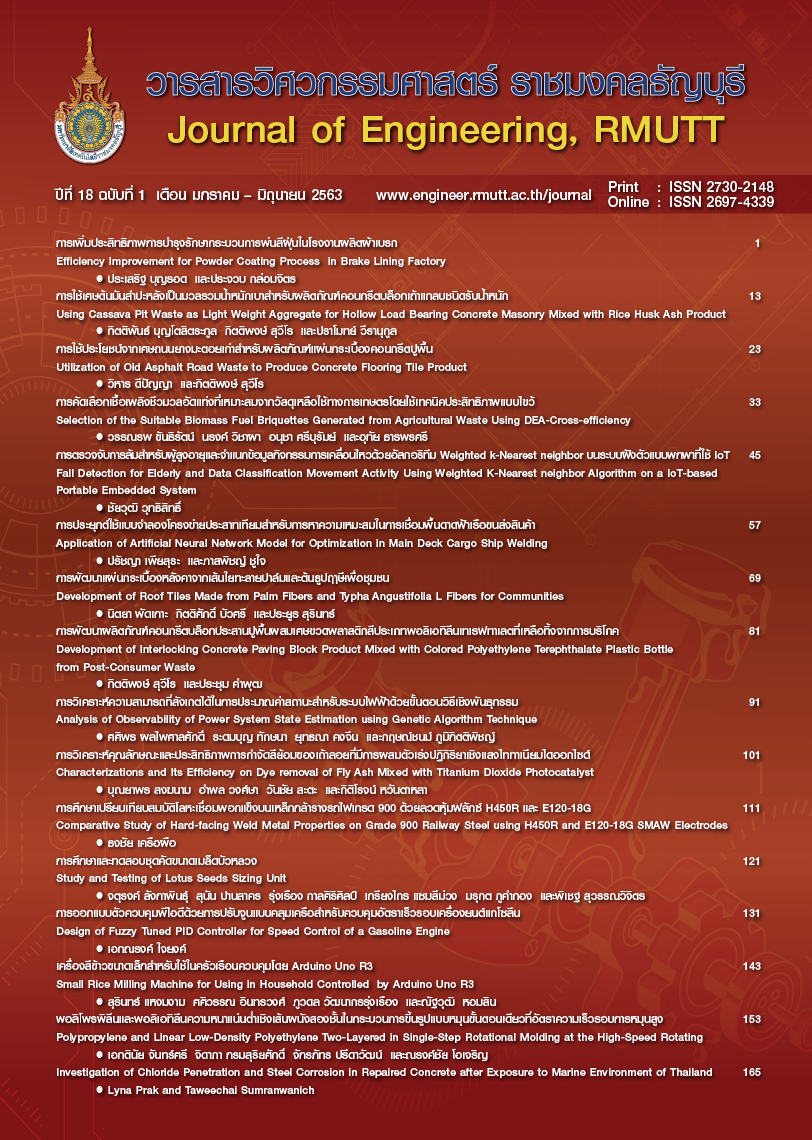Development of Roof Tiles Made from Palm Fibers and Typha Angustifolia L Fibers for Communities
Main Article Content
Abstract
The production of roof tiles from palm fiber and typha angustifolia L fibers for local communities : synthetic adhesive isocyanate resin (pMDI), volume 5% and 10% by weight was used as a binder with the density of the designated roof tiles 600 kg / m3 and the size of the sheets 300X320X15 mm. Physical properties tests showed the density value, moisture content, absorption, water tightness, Inflating and thickness. Mechanical properties: modulus of rupture resistance, elastic modulus resistance modulus and impact strength which used synthetic isocyanate resin 10% by weight to give better properties. The physical and mechanical properties within the standard criteria of TIS 876-2547, TIS 535–2556, JIS A 5908-2003 and ASTM D 256-06a. Thermal properties thermal conductivity and heat resistance were tested according to the standards of ASTM C 177-2010. It was found that using synthetic adhesive isocyanate resin where the adhesive content was 5% had better thermal conductivity while the synthetic adhesive isocyanates resin with 10% adhesives had better heat resistance. From the study, the roof titles can be used as construction and renewable materials instead of the ones from asbestos cement.
Article Details
The manuscript, information, content, picture and so forth which were published on Frontiers in engineering innovation research has been a copyright of this journal only. There is not allow anyone or any organize to duplicate all content or some document for unethical publication.
References
OonjittichaiW.Wood Substituted.Biocomposites.Forest researchand development bureau.WoodDevelopment division.2012(in Thai)
Center of fuels and energy fromBiomass, Biomass potential inthailand. Departmentof chemical technology [Internet].Chulalongkorn University;2016[cited 2019 Sep 16].available from:http://www.iscisaraburee.sc.chula.ac.th/2017/index.php/2016/06/06/i-sink-under-the-weight-of-the-splendour/
Anantaratanachai S, RampeungJaroenyot. Product of typha paper of automatic machine.department of Industrialengineering. Faculty of engineering and Architecture.Rajamangala University of technology suvarnabhumi. 2013 (in Thai)
Shinoj S, Visvanathan R, Panigraphi,S,Koch Ubabu M.Oil palm fiber (OPF) and itscomposites: A Review. Industrialcrops and product.2011;33:7-22 (in Thai)
Suntijitto A. Influence of cellulose fiber on mechanical andthermal properties offibercement roof sheets in hot-humid climate. Departmentof Architecture. Faculty of Architecture and planning.Thammasat University. 2011 (in Thai)
Padkoh N.Investigationof tileroofsproperties of naturalfibers frompineapple leaffibers andmaize huskfiber.Srinakharinwirot EngineeringJournal.2017; 12 (1):11-9 (in Thai)
Thailand IndustrialStandardsInstitute.Flat pressedparticleboards. TIS. 876-2547. Ministry of Industry.2004:1-17(in Thai)
Thailand Industrial StandardsInstitute.Concrete roof tiles.TIS. 535-2556.Ministry ofIndustry.2013:1-14(in Thai)
Japanese Standards Associationparticleboard,JIS A 5908-2003.Japaneseindustrial standard. Tokyo, HohbunshaCo.Ltd. 2003:23
American Society for testing and materials. ASTM D 256 –06aStandard test methods fordetermining the izodpendulumimpact resistance ofplastics.In 1990Annual book of ASTMStandards.philadelphia ASTM. 2006;8(1):57-73
American Society for testing andmaterials. ,ASTM C 177-10Standard test method forSteady-State heat flux measurementsandthermaltransmission properties bymeans of the ouarded-host-plate apparatus. In annual bookof ASTM Standards,MD,U.S.A. 2010;04(6): 21-32
Jarunjaruphat N,Salinee.Theparticleboardmanufacturingfrom Agricultural wast. TheJournal of KMUTNB.2018;28 (2):469-76 (in Thai)
Thongsri K, Parmotmuang M.The study and developmentof contemporary productdecoration for real woodidentity in thailand.RajamangalaUniversity oftechnology Phra nakhon.Architecture and design.2015 (in Thai)


